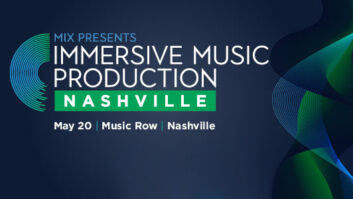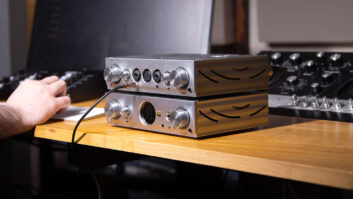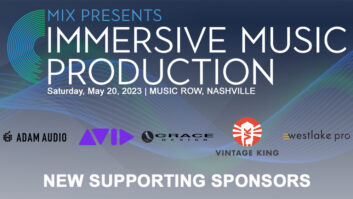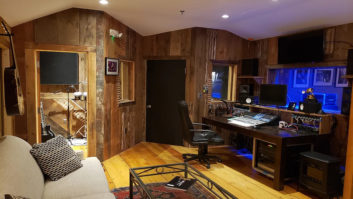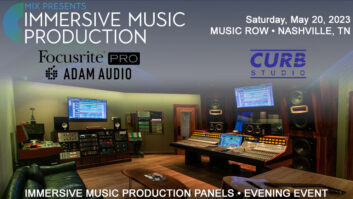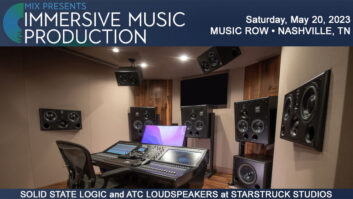
Hamilton, ON—Almost exactly one year after Roman Marcone had to shut down his Halo Music Studio in Hamilton, he and business partner Corey Stevens are about to relaunch at a new location. If you’re a fan of Rush, The Police or the Bee Gees, you may get a sense of déjà vu about the place—and for good reason.
Marcone’s relationship with his former landlords began to sour in early 2019 after they tried, unsuccessfully, to sell the building out from under him. Then a heavy rainstorm in April nearly turned a minor roof leak into a major disaster, damaging some of the equipment.
“People were unsure about booking us,” not knowing if Halo would remain open, says Marcone. “We said, alright, we’re out.”
He put the gear into storage and—once bitten, twice shy—went looking for a building to buy. He eventually found a single-story commercial building designed by Trevor Garwood Jones’ firm in 1972. (An award-winning architect, Garwood Jones designed some of the most prominent buildings in Hamilton.) “It’s the only one on the street that’s not a Victorian home,” he says.

Recording Engineer Nick Blagona, Dead at 74, by Clive Young, Jan. 6, 2020
While finishing an album he’d started at Halo at the home of longtime friend Nick Blagona, an engineer and producer who worked with the Moody Blues, King Crimson, The Police, Deep Purple and numerous others, they discussed the design of the new building. “He said, ‘Le Studio’s control room was awesome and there isn’t another one like it. Let’s do that.’ I’d never even thought of that,” says Marcone.
Blagona had been chief engineer at Le Studio in Morin Heights, north of Montreal, and had designed the facility with owner, engineer and producer André Perry in the early 1970s. Le Studio hosted many major artists over the years, including Rush, who recorded seven albums there, and the Bee Gees, who worked on Saturday Night Fever at the studio. The Police tracked “Every Little Thing She Does Is Magic” there. Derelict since 2008, the studio burned down in 2011.
The idea began to make a lot of sense. “We went over his plans and photos and I made a 3D rendering and managed to make it fit exactly in our new building,” says Marcone.
As for the requisite gear, “We had the SSL that they’d had,” Marcone says, an E/G series previously owned by Atlanta’s Doppler Studios. Halo already had a Studer A80 MkII multitrack machine, too. To complete the signal chain, he needed a pair of Urei 813 main monitors. “I did a quick search and found a pair in Toronto for sale. They’d been discounted because they’d been on sale for a year and nobody had bought them.” Likewise with the Studer A68 amplifiers: “They’re hard to find, but some came up on eBay from British Columbia. So it all fell into place,” he says.
Sacrificing a Ferrari for Halo Studio’s Sound, by Steve Harvey, Jan. 12, 2018
But the reborn Halo is not an attempt to replicate Le Studio. “We managed to make the control room the same size and shape, but we’ve added modern principles for speaker placement and whatnot,” he says.

The live room’s shape is similar to the Morin Heights space as well, just a little smaller. Anyone who has seen a Rush video recorded at Le Studio will remember the wall of glass. Halo has that covered, too. “The whole front of the building is glass,” says Marcone. “We’ve built a second wall, so we have an entrance foyer, then there’s a wall of windows set back from the front, so you get the light but there’s a sound buffer.”
As planning progressed, Marcone found himself working with more Le Studio alumni. “I started talking to Roger Ginsley, who has always maintained my gear. Roger was also that guy at Le Studio; I didn’t realize.”
Ginsley had been a junior engineer with Blagona in the UK and moved to Canada to replace Jean-Luc Louradour, now an electroacoustic engineer, at Le Studio. “Roger said, ‘Talk to Jean-Luc, he knows a lot about studio design, speaker placement, room shapes and dimensions,’” says Marcone.

“They’ve all been super helpful. Roger has helped get all the tech and gear organized. Jean-Luc designed the control room with me, helping with the principles of floating the room and the materials to use. He took the design Nick and I had made and turned it into something a little more modern, and very accurate. Then Nick was helpful with the layout, the flow, the vibe and the considerations for artists. And Mary Jane Russell, Nick’s 35-year partner and wife, has been instrumental in helping with the decor and vibe.”
He adds, “I should mention my amazing wife, Neva, for being so wonderfully understanding and supportive in the creation process of our space. It’s half hers, in reality.”
Marcone and Stevens did the lion’s share of the general contracting work to keep the project within budget. “We’ve focused on the right things that they did back in the day,” he says. “It was still way more than I expected to spend, but I own the place, so it’s a forever studio.”
Like Le Studio, Halo’s control room walls are cedar clad. “And we’re getting a neon sign with the Halo logo,” he adds. A former board room is now a “vibe spot,” complete with a black and white checkerboard floor like the original Motown room, inspired by an eight-year-old Facebook memory posted by Blagona.

“Nick’s had a hand in a lot of this. He brought it to life for us, in a sense. It’s a shame he didn’t get a chance to see it,” says Marcone. Blagona passed away on Jan. 4 from complications resulting from kidney, heart and lung diseases.
“Even to his last day, he was talking about how excited he was for this to exist. We’re holding Nick’s celebration of life on his 75th birthday, May 24, at Halo as our grand opening.”
On that final visit to the hospital, “He asked me to finish the records he was working on. He trusted me and my ears. As an audio engineer, that’s one of the highest compliments and honors,” he says.
“Nick meant a lot—to music, this city and me.”
Halo Music • www.halomusic.ca
